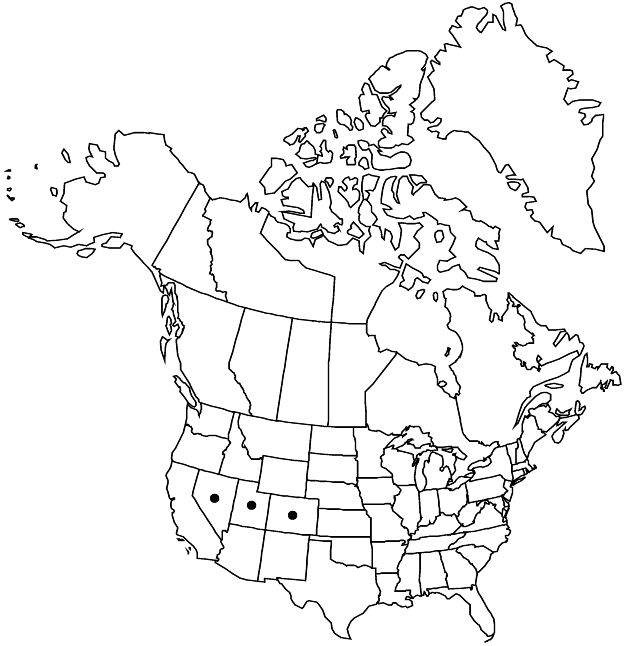Mentzelia lagarosa
Madroño 57: 247. 2010.
Plants biennial, candelabra-form. Stems solitary, erect, straight; branches distal, distal longest, antrorse, straight; hairy. Leaves: blade 11.3–103 × 4.8–20.1 mm, widest intersinus distance 1.2–5.7 mm; proximal oblanceolate to elliptic, margins pinnate to pinnatisect, lobes 8–20, slightly antrorse or perpendicular to leaf axis, 1.4–8.2 mm; distal elliptic to lanceolate, base not clasping, margins pinnatisect, lobes 6–16, slightly antrorse or perpendicular to leaf axis, 1.6–7.5 mm; abaxial surface with simple grappling-hook, complex grappling-hook, and occasionally needlelike trichomes, adaxial surface with simple grappling-hook and needlelike trichomes. Bracts: margins usually entire, sometimes toothed or pinnate. Flowers: petals golden yellow, 8.3–13 × 2.2–5.4 mm, apex acute or rounded, glabrous abaxially; stamens golden yellow, 5 outermost petaloid, filaments narrowly spatulate, slightly clawed, 6.5–10.7 × 1.7–4.3 mm, without anthers, second whorl with anthers; anthers straight after dehiscence, epidermis smooth; styles 6.1–10.2 mm. Capsules cylindric, 12.1–21.2 × 4.9–7.6 mm, base tapering or rounded, not longitudinally ridged. Seeds: coat anticlinal cell walls wavy, papillae 29–31 per cell. 2n = 22.
Phenology: Flowering Jun–Aug(–Oct).
Habitat: Sparsely vegetated hills, slopes, knolls, white ash and limestone soils.
Elevation: 1500–2500 m.
Distribution

Colo., Nev., Utah.
Discussion
Mentzelia lagarosa is allopatric with two of the three species most similar to it, namely M. holmgreniorum and M. filifolia, and nearly allopatric with the third, M. laciniata. Where the ranges of M. lagarosa and M. laciniata overlap in western Colorado, they can be distinguished by petal length [8.3–13 mm in M. lagarosa versus 14–23.8(–26) mm in M. laciniata], outermost stamen length (6.5–10.7 mm in M. lagarosa versus 12–20 mm in M. laciniata), and number of seed coat cell papillae (29–31 per cell in M. lagarosa versus 5–14 per cell in M. laciniata); in addition, M. lagarosa bears both simple grappling-hook and needlelike trichomes on its adaxial leaf blade surfaces, whereas leaf blades of M. laciniata bear only needlelike trichomes adaxially. In the Intermountain Flora, N. H. Holmgren et al. (2005) treated M. lagarosa as a synonym of M. multiflora, but J. J. Schenk and L. Hufford (2011) showed not only that M. lagarosa is distinct from M. multiflora, but also that the latter does not occur in the intermountain region.
Selected References
None.